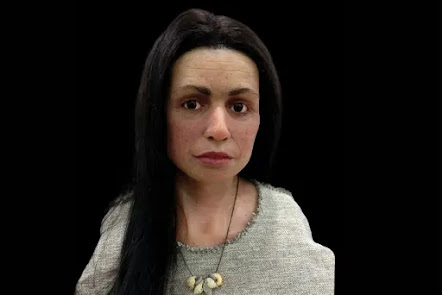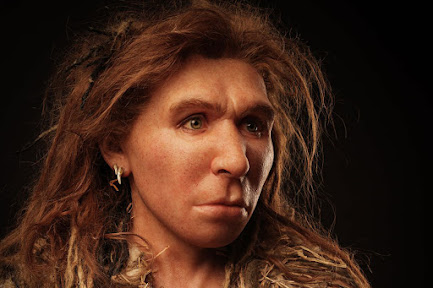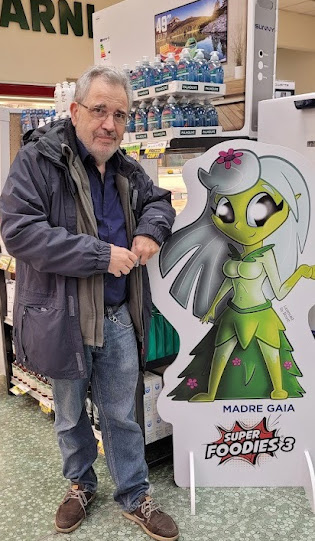When was the last time that you walked through an old-growth forest? Do you remember the silence, the stillness of the air, the sensation of awe, the feeling that you are walking in a sacred place? The inside of a forest looks like a cathedral or, perhaps, it is the inside of a cathedral that is built in such a way to resemble a forest, with columns as trees and vaults as the canopy. If you don't have a forest or a cathedral nearby, you can get the same feeling by watching the masterful scene of the forest-God appearing in Miyazaki's movie, "Mononoke no Hime" (The Princess of the Ghosts).
As usual, if something exists, there is some reason for it to exist. Within some limits, evolution may take different paths simply because it has started moving in a certain direction and it cannot move back. But, as things stand on Earth, wooden trunks are perfectly optimized for their purpose of support of a creature that doesn't move. Tree trunks (not palms, though) grow in concentric layers: it is well known that you can date a tree by counting the growth rings in its trunk. As a new layer grows, the inside layers die. They become just a support for the external layer called the “cambium” which is the living part of the trunk, containing the all-important “xylem”, the ducts that bring water and nutrients from the roots to the leaves. The cambium also contains the "phloem," another set of ducts that move water loaded with sugars in the opposite direction, toward the roots. The inner part of the trunk is dead, so it has no metabolic cost for the tree. Yet, it keeps providing the static support the tree needs.
The disadvantage is that, because the internal part of the wood is dead, when a branch or a trunk is broken, it cannot be healed by reconnecting the two parts together. In animals, instead, the bones are alive: there is blood flowing through them. So, they can regrow and rebuild the damaged parts. It is probably a necessary feature for animals. They jump, run, fly, fall, roll, and do more acrobatic feats, often resulting in broken bones. Of course, a broken bone is a major danger, especially for a large animal. We don’t know exactly how many animals suffer broken bones and survive, but it seems that it is not uncommon: live bones are a crucial survival feature [6], [7]. But that's not so important for trees: they do not move and the main stress they face is a heavy gust of wind. But trees tend to protect themselves from wind by shouldering against each other – which is, by the way, another typical holobiont characteristic: trees help each other resisting wind, but not because they are ordered to do so by a master tree. It is just the way they are.
So, there is plenty of logic in the fact that trees use wood as a structural material. They are not the only creatures doing that. Bamboos (bambusoideae), are also wooden, but they are not trees. They are a form of grass that appeared on Earth just about 30 million years ago, when they developed an evolutionary innovation that makes their "trunk” lighter, being hollow. So, they can take much more stress than trees before breaking and that inspired many Oriental philosophers about the advantages of bending without breaking. Among animals, insects and arthropods use a structural material similar to wood, called "chitin." They didn't solve the problem of how to make it grow with the whole organism, so use it as an exoskeleton that they need to replace as they grow.
Now, let's go to another question about trees. How does their metabolism work? You know that trees create their own food, carbohydrates (sugar), by photosynthesis, a process powered by solar light that works by combining water and carbon dioxide molecules. One problem is that sunlight arrives from above, whereas trees extract water from the ground. So, how do they manage to pump water all the way to the leaves?
We animals are familiar with the way water (actually, blood) is pumped inside our bodies. It is done by an organ called "heart," basically a "positive displacement pump" powered by muscles. Hearts are wonderful machines, but expensive in terms of the energy they need and, unfortunately, prone to failure as we age. But trees, as we all know, have no muscles and no moving parts. There is no “heart” anywhere inside a tree. It is because only the feverish metabolism of animals can afford to use so much energy as it is used in hearts. Trees are slower and smarter (and they live much longer than primates). They use very little energy to pump water by exploiting capillary forces and small pressure differences in their environment.
But why do trees go to such an effort to become tall? If the idea is to collect solar light, which is the business all plants are engaged in, there is just as much of it at the ground level as there is at 100 meters of height. Richard Dawkins was perplexed about this point in his book “The Greatest Show on Earth” (2009), where he said:
“Look at a single tall tree standing proud in the middle of an open area. Why is it so tall? Not to be closer to the sun! That long trunk could be shortened until the crown of the tree was splayed out over the ground, with no loss in photons and huge savings in cost. So why go to all that expense of pushing the crown of the tree up towards the sky? The answer eludes us until we realize that the natural habitat of such a tree is a forest. Trees are tall to overtop rival trees - of the same and other species. … A familiar example is a suggested agreement to sit, rather than stand, when watching a spectacle such as a horse race. If everybody sat, tall people would still get a better view than short people, just as they would if everybody stood, but with the advantage that sitting is more comfortable for everybody. The problems start when one short person sitting behind a tall person stands, to get a better view. Immediately, the person sitting behind him stands, in order to see anything at all. A wave of standing sweeps around the field, until everybody is standing. In the end, everybody is worse off than they would be if they had all stayed sitting.”Dawkins is a sharp thinker but sometimes he takes the wrong road. Here, he reasons like a primate, actually a male primate (not surprising, because it is what he is). The idea that trees “compete with rival trees – of the same and other species” just doesn’t work. Trees can be male and female, although in ways that primates would find weird, for instance with both male and female organs on the same plant. But male trees do not fight for female trees, as male primates do with female primates. A tree would have no advantage in killing its neighbors by shadowing them -- that wouldn't provide "him" or "her" with more food or more sexual partners. Killing the neighbors would perhaps allow a tree to grow a little larger, but, in exchange, it would be more exposed to the gust of wind that could topple it. In the real world, trees protect each other by staying together and avoiding the full impact of gusts of wind.
That doesn’t mean that trees do not compete with other trees or other kinds of plants. They do, by all means. It is typical for a forest especially after an area has been damaged, for instance by fire. In that area, you see growing first the plants that grow faster, typically herbs. Then, they are replaced by shrubs, and finally by trees. The mechanism is generated by the shadowing of the shorter species created by the taller ones. It is a process called "recolonization" that may take decades, or even centuries before the burned patch becomes indistinguishable from the rest of the forest.
These are dynamic processes: fires are part and parcel of the ecosystem, not disasters. Some trees, such as the Australian eucalypti and the African palms seem to have evolved with the specific purpose of burning as fast as possible and spreading flames and sparks around. Have you noticed how palms are “hairy”? They are engineered in such a way to catch fire easily. So much, that it may be dangerous to prune a palm by using a chainsaw while climbing it. A spark from the engine may set on fire the dry wood filaments and that may be very bad for the person strapped to the trunk. It is not that palms could have evolved this feature to defend themselves from chainsaw-yielding monkeys, but they are fast-growing plants that may benefit from how a fire cleans a swat of ground, letting them re-colonize it faster than other species. Note how palms act like kamikaze: single plants sacrifice themselves for the survival of their seed. It is another feature of holobionts. Some primates do the same, but it is rare.
Other kinds of trees adopt the opposite approach. They optimize their chances for survival when exposed to fire by means of thick bark. The ponderosa pine (Pinus ponderosa) is an example of a plant adopting this strategy. Then there are more tricks: have you ever wondered why some pinecones are so sticky and resinous? The idea is that the resin glues the cone to a branch or to the bark of the tree and keeps the seeds inside. If a fire burns the tree, the resin melts, and the seeds inside are left free to germinate. More evidence that fires are not a bug but a feature of the system.
In the end, a forest, as we saw, is a typical holobiont. Holobionts do not evolve by the fight for survival that some interpretations of Darwin’s theory had imagined being the rule in the ecosystem. Holobionts can be ruthless when it is necessary to eliminate the unfit, but they aim at an amicable convivence of the creatures that are fit enough.

The concept of biotic pump [11] was proposed by Viktor Gorshkov, Anastassia Makarieva, and others, as part of the wider concept of biotic regulation [12]. It is a profound synthesis of how the ecosphere works: it emphasizes its regulating power that keeps the ecosystem from straying away from the conditions that make it possible for biological life to exist. From this work comes the idea that the ecosystemic imbalance we call "climate change" is caused only in part by CO2 emissions. Another important factor is the ongoing deforestation. This is, of course, a controversial position. The general opinion among climatologists in the West is that growing a forest has a cooling effect because it removes some CO2 from the atmosphere. But, once a forest has reached its stable state, it has a warming effect on Earth’s climate because its albedo (the light reflected back into space) is lower than that of the bare ground. But studies exist [13] that show how forests cool the Earth not only by sequestering carbon in the form of biomass but because of a biophysical effect related to evapotranspiration. That is, the water evaporates at low altitudes from the leaves, causing cooling. It returns the heat when it condenses in the form of clouds, but the heat emissions at high altitudes are more easily dispersed towards space because the main greenhouse gas, the water, exists in very small concentrations. It may be a minor effect compared to that of the albedo, but it is a point not very well quantified.
The concept of biotic pump states that forests act as "planetary pumping systems," carrying water from the atmosphere above the oceans up to thousands of kilometers inland. It is the mechanism that generates the “atmospheric rivers” that supply water to lands that are far away from the seas [14]. The biotic pump mechanism depends on quantitative factors that are still little known. But it seems that the water transpired by trees condenses above the forest canopy and the phase transition from gas to liquid generates a pressure drop. This drop pulls air from the surroundings, all the way from the moist air over the sea. This mechanism is what allows the inner areas of the continents to receive sufficient rain to be forested. It doesn’t work everywhere, in Northern Africa, for instance, there are no forests that bring the water inland, and the result is the desert region we call the Sahara. But the biotic pump operates in Northern Eurasia, central Africa, India, Indonesia, Southern, and Northern America.
The concept of the biotic pump is an especially clear example of how holobionts operate. Single trees don’t evaporate water in the air because they somehow “know” that this evaporation will benefit other trees. They do that because they need to generate the pressure difference they need to pull water and nutrients from their roots. In a certain sense, evapotranspiration is an inefficient process because, from the viewpoint of an individual tree, a lot of water (maybe more than 95%) is "wasted" in the form of water vapor and not used for photosynthesis. But, from the viewpoint of a forest, the inefficiency of single trees is what generates the pull of humidity from the sea that makes it possible for the forest to survive. Without the biotic pump, the forest would quickly run out of water and die. It often happens with the rush to "plant trees to stop global warming" that well-intentioned humans are engaged in, nowadays. It may do more harm than good: to stabilize the climate, we do not need just trees, we need forests.
[1] S. W. Simard, D. A. Perry, M. D. Jones, D. D. Myrold, D. M. Durall, and R. Molina, “Net transfer of carbon between ectomycorrhizal tree species in the field,” Nature, vol. 388, no. 6642, pp. 579–582, Aug. 1997, doi: 10.1038/41557.
[2] T. Browne, “Hydriotaphia,” in Sir Thomas Browne’s works, volume 3 (1835), S. Wilkin, Ed. W. Pickering, 1835.
[3] Shilong Piao et al., “Characteristics, drivers and feedbacks of global greening,” | Nature Reviews Earth & Environment, vol. 1, pp. 14–27.
[4] D. Reay, Nitrogen and Climate Change: An Explosive Story. Palgrave Macmillan UK, 2015. doi: 10.1057/9781137286963.
[5] A. Sneed, “Ask the Experts: Does Rising CO2 Benefit Plants?,” Scientific American. https://www.scientificamerican.com/article/ask-the-experts-does-rising-co2-benefit-plants1/ (accessed Jun. 23, 2021).
[6] S. Hoffman, “Ape Fracture Patterns Show Higher Incidence in More Arboreal Species,” Discussions, vol. 8, no. 2, 2012, Accessed: Jun. 26, 2021. [Online]. Available: http://www.inquiriesjournal.com/articles/799/ape-fracture-patterns-show-higher-incidence-in-more-arboreal-species
[7] C. Bulstrode, J. King, and B. Roper, “What happens to wild animals with broken bones?,” Lancet, vol. 1, no. 8471, pp. 29–31, Jan. 1986, doi: 10.1016/s0140-6736(86)91905-7.
[8] Pi. Cruiziat, “Plant Physiology and Development, Sixth Edition,” in Plant Physiology and Development, Oxfprd University Press, 2006. Accessed: Jun. 24, 2021. [Online]. Available: http://6e.plantphys.net/essay04.03.html
[9] L. J. Williams, A. Paquette, J. Cavender-Bares, C. Messier, and P. B. Reich, “Spatial complementarity in tree crowns explains overyielding in species mixtures,” Nat Ecol Evol, vol. 1, no. 4, pp. 1–7, Mar. 2017, doi: 10.1038/s41559-016-0063.
[10] S. Kothari, R. A. Montgomery, and J. Cavender-Bares, “Physiological responses to light explain competition and facilitation in a tree diversity experiment,” Journal of Ecology, vol. 109, no. 5, pp. 2000–2018, 2021, doi: 10.1111/1365-2745.13637.
[11] Gorshkov, V.G and Makarieva, A.M., “Biotic pump of atmospheric moisture as driver of the hydrological cycle on land,” Hydrology and Earth System Sciences Discussions, vol. 3, pp. 2621–2673, 2006.
[12] V. G. Gorshkov, A. Mikhaĭlovna. Makarʹeva, and V. V. Gorshkov, Biotic regulation of the environment : key issue of global change. Springer-Verlag, 2000. Accessed: Sep. 24, 2017. [Online]. Available: http://www.springer.com/it/book/9781852331818
[13] R. Alkama and A. Cescatti, “Biophysical climate impacts of recent changes in global forest cover,” Science, vol. 351, no. 6273, pp. 600–604, Feb. 2016, doi: 10.1126/science.aac8083.
[14] F. Pearce, “A controversial Russian theory claims forests don’t just make rain—they make wind,” Science | AAAS, Jun. 18, 2020. https://www.sciencemag.org/news/2020/06/controversial-russian-theory-claims-forests-don-t-just-make-rain-they-make-wind (accessed Jun. 25, 2021).

















